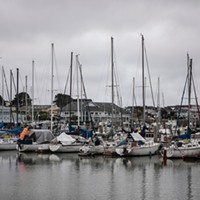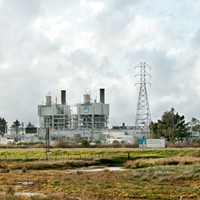[
{
"name": "Top Stories Video Pair",
"insertPoint": "7",
"component": "17087298",
"parentWrapperClass": "fdn-ads-inline-content-block",
"requiredCountToDisplay": "1"
}
]
Some people throw up their hands in despair when they talk of climate change. Others deny there is even a problem. But somewhere in the middle, quietly and without much fanfare, local governments are considering realistic steps to cut back on the carbon dioxide emissions that are heating up the atmosphere.
California, which has led the nation on environmental protection for decades, started demanding involvement from cities and counties in 2009 when it amended the California Environmental Quality Act (CEQA) to require that every city and county to address the climate change impacts of projects they approve.
Local governments had the choice of either doing this on a project-by-project basis or by creating a Climate Action Plan for the whole community that would enumerate the quantity of greenhouse gases being emitted, and come up with plans to reduce them.
Several communities responded. Blue Lake created its own Climate Action Plan in 2014. The Hoopa Valley Housing Authority wrote a plan, although it is uncertain when or if it was adopted. Trinidad wrote one in 2016 but it remains in draft form. Arcata had already created its own greenhouse gas emissions inventory back in 2009, even before CEQA was amended. The county produced a draft Climate Action Plan that was supposed to be part of the General Plan Update but it was never adopted.
The county Planning Department got started on this effort again on May 20, filling a room with about 50 local residents and papering the walls with large posters showing various climate-related problems and some potential solutions. This time, however, the idea is to produce a regional plan that would include all seven cities and the unincorporated areas of the county.
The first step, determining how much greenhouse gas is currently being emitted in the region, involves a lot of mathematical heavy lifting and has already been completed by experts at the Redwood Coast Energy Authority. The next step is to come up with some targets for reducing that amount, hopefully in line with state mandates, which specify a 40-percent reduction below 1990 levels by 2030. The third and most important step is determining what changes the community is willing to make in order to reach these goals.
Connor McGuigan, a youthful CivicSpark AmeriCorps fellow on loan to the Humboldt County Planning Department, led the discussion.
"Climate change doesn't honor jurisdictional boundaries," he said. "We need to combine our resources and take a regional approach to solving these problems."
Each member of the audience was supplied with a paper full of green dots, which could be pasted on his or her favorite problems or solutions. Transportation is the big monster, producing 48 percent of the region's emissions. This is hardly surprising in a large rural county, where most people rely on their cars to get around and public transportation options are sparse. Consequently, the transportation poster attracted a lot of green dots.
Zero-emission vehicles, more commonly known as electric cars, were a popular solution. Improving transit so that bus lines are more available to people's ordinary needs was another green dot magnet. So was adding and improving bike lanes and sidewalks.
Sustainable land use planning was another big draw. This means basically avoiding urban sprawl by encouraging infill and mixed-use development.
People were enthusiastic about solar micro-grids to produce local electrical power as well as solar rooftop panels on as many buildings as possible. Many yearned for the day when all this locally-generated electricity would heat their homes and cook their food, replacing natural gas, propane and firewood as fuel sources.
People also liked carbon sequestration, which is a fancy term for allowing trees and other green things to grow. A growing forest sucks carbon dioxide out of the atmosphere and can help a community compensate for the greenhouse gases generated by burning fossil fuels. Trees can be planted even in the most urban areas and median strips of roadways can be converted to green spaces. Preserving agricultural lands and open space also contributes to a community's carbon sequestration.
The most interesting of the posters was the "Big Idea Board," which was simply a big blank piece of paper on which people could write down any ideas for reducing greenhouse gas emissions that had not already been considered.
"Goat herds instead of gas-powered equipment to maintain city landscapes," one resident wrote.
"A small city tax for climate action," wrote another resident. "Could be a carbon tax or related to personal income."
Others seemed harsher.
"Add barriers to discourage immigration to Humboldt," one resident wrote.
"Get rid of the cachet of wood-burning stoves," another wrote about the only heating source for much of rural Humboldt.
"Eliminate the glamour of flying," someone wrote, referring to the high emission rate of airplanes.
One commenter came more directly to the point of it all.
"Hold a meeting like this that approaches the social issues that come with climate change. At this point, climate change is a social problem and people need to figure out how to change their ways of life."
Presumably, the Planning Department will take all of these ideas and work them into the next phase of the study, which is coming up with actual plans for reduction, and figuring out a way to pay for them. There is already plenty of material available on how to do this. The state has posted numerous online documents on how to write and actualize a plan, and has a database of funding sources.
Lest anybody think this is just another exercise in pencil-pushing, they should be aware that the Sierra Club has sued Napa and San Diego counties for having inadequate Climate Action Plans. River Watch, a Sonoma County environmental group, has also sued Sonoma County for the same reason.
According to the 2009 California Climate Adaptation Strategy, "Communities that begin planning now will have the best options for adapting to climate change. ... The longer communities wait, the greater the costs of the impacts and the costs to react to those impacts. "
Elaine Weinreb is a freelance journalist. She tries to re-pay the state of California for giving her a degree in environmental studies and planning (Sonoma State University) at a time when tuition was still affordable.
Speaking of...
more from the author
-
Trouble on the Mountain
A popular outdoor recreation area is also a makeshift shooting range, causing growing safety concerns
- Jan 11, 2024
- More »
Latest in News
Readers also liked…
-
Through Mark Larson's Lens
A local photographer's favorite images of 2022 in Humboldt
- Jan 5, 2023
-
'To Celebrate Our Sovereignty'
Yurok Tribe to host gathering honoring 'ultimate river warrior' on the anniversary of the U.S. Supreme Court ruling that changed everything
- Jun 8, 2023



































